Birdfinding.info ⇒ The summer-breeding North Atlantic form of Band-rumped Storm-Petrel is locally common from around April to October around the islands where it breeds. It can be seen most reliably on summer pelagic trips out of Madeira, and sometimes from shore at Ponta do Sol and Ponta do Garajau. It might occur in Gulf Stream waters off of the eastern U.S. amid the much higher numbers of its close relative, “Grant’s Storm-Petrel”, but this is difficult to confirm.
“Madeiran Storm-Petrel”
Hydrobates castro castro
Breeds on Madeira, the Selvagens, and the Canaries; nonbreeding range uncertain.
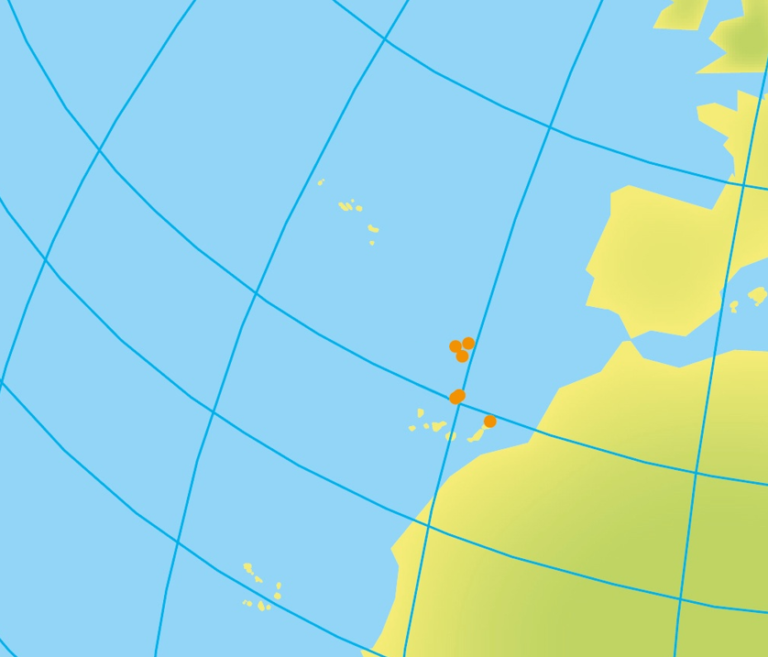
Approximate locations of “Madeiran Storm-Petrel” breeding colonies. © The Sound Approach 2019
Breeding. Breeds from late March to October on islands of the Madeiran archipelago (Madeira, Deserta Grande, Bugio, and Ilhéu do Farol) and the Selvagens (Selvagem Grande and Selvagem Pequena), and on one or more islets north of Lanzarote in the Canary Islands.
Adults return in March and April and lay their eggs in June or early July. Juveniles fledge in September and October.
Nonbreeding. Distribution at sea is essentially unknown due in part to the challenge of distinguishing it from the three other band-rumped-type storm-petrels that also breed in the North Atlantic—all of which are effectively identical except when vocalizing on the breeding grounds.
Based on the molt-stage of some individuals and side-by-side comparisons with the predominant “Grant’s Storm-Petrel”, some of the band-rumped-type storm-petrels that occur each year in the Gulf Stream waters of the western North Atlantic (and possibly also in the Gulf of Mexico) have been tentatively identified as “Madeiran”. These identifications may be correct, but are questionable due to potential confusion with juvenile and first-year “Grant’s” (likely to be at different molt-stages than post-breeding adults), as well as Monteiro’s Storm-Petrel, which breeds around the same time as “Madeiran” and has similar molt timing.
Identification
As a form or potentially cryptic species within the Band-rumped Storm-Petrel complex, “Madeiran” is visually indistinguishable from other band-rumped-type storm-petrels under most circumstances. It averages slightly smaller than the others—but not enough to be the basis for field identification.
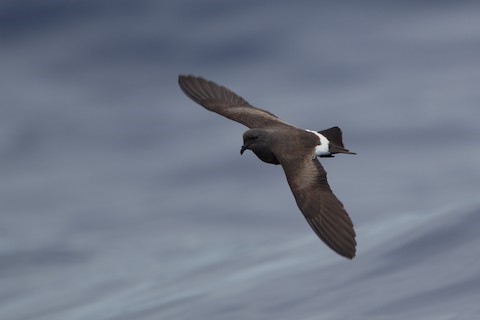
“Madeiran Storm-Petrel”, H. c. castro, with tail appearing notched in this posture. (Offshore from Bugio, Madeira; June 8, 2011.) © Simon Colenutt
Like other band-rumped-type storm-petrels, “Madeiran” is dark-brown overall, with an even white band across the rump that usually extends partway down the sides of the rump to the undertail. Its tail typically appears square-tipped, but can also appear notched.
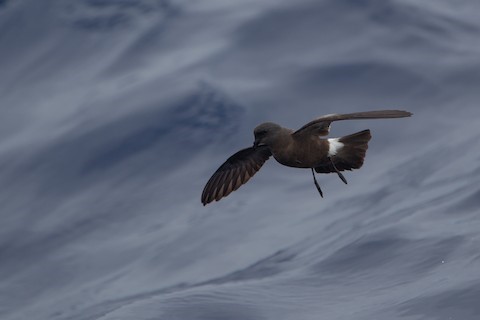
“Madeiran Storm-Petrel”, H. c. castro, with tail appearing wedge-shaped in this posture. (Offshore from Bugio, Madeira; June 8, 2011.) © Simon Colenutt
As with most dark storm-petrels, all band-rumped-types typically show a paler brown or whitish diagonal stripe on the wing coverts, but the boldness varies depending on molt-stage and lighting. So the apparent color and boldness of the wingbar can provide clues to the age and molt-stage of closely observed individuals.
Juveniles and freshly molted adults have the most pronounced wingbars. On juveniles the bar appears silvery. On fresh adults, the bar is blond. With feather-wear, the bar diminishes and may disappear entirely by the time the next molt begins.
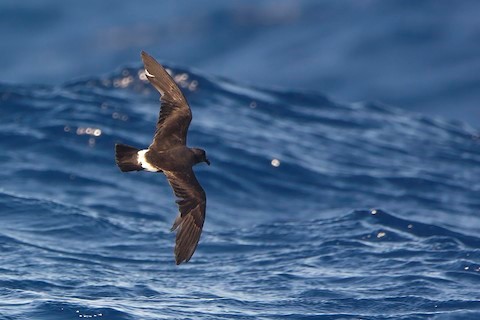
“Madeiran Storm-Petrel”, H. c. castro —likely this subspecies, based on molt-stage and season. (Offshore northeast of Lanzarote, Canary Islands, Spain; November 1, 2014.) © Miguel Rouco
For conditions where wing-molt can be discerned: adult “Madeiran” begins molting in late summer and completes in winter; and first-year “Madeiran” would likely begin molting in June and complete in October (see Howell & Zufelt 2021). Note that this expected seasonality of feather-wear and replacement is effectively identical to that of Monteiro’s.
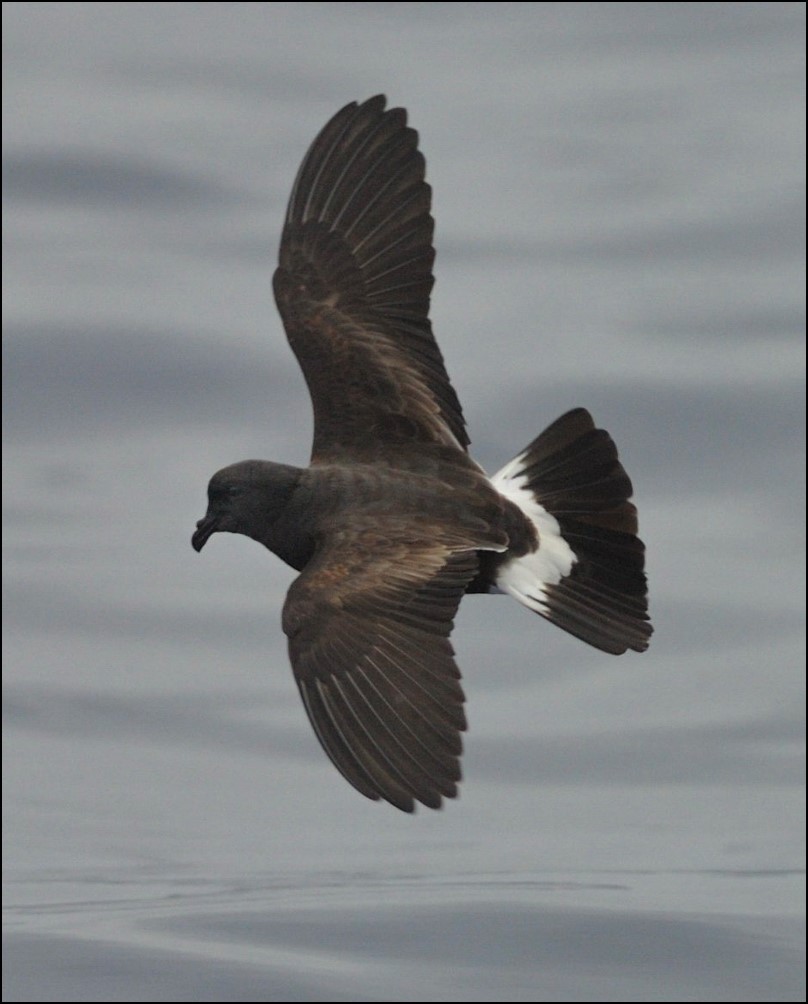
“Madeiran Storm-Petrel”, H. c. castro, in fresh plumage. (Offshore from Madeira; May 2011.) © Kirk Zufelt
Notes
Monotypic form, one of seven or more potentially distinct forms of Band-rumped Storm-Petrel (castro), which is in the midst of taxonomic revisions. Eventually, it seems likely that the two North Atlantic forms, “Madeiran” (castro) and “Grant’s” (ssp. nova, presumptively to be named granti), will be classified separately from the South Atlantic and Pacific forms.
See below for a comparison of the “Madeiran Storm-Petrel” with other Atlantic members of the Band-rumped Storm-Petrel complex.
Cf. Other Atlantic Band-rumped-type storm-petrels. At least six cryptic species or forms in the Band-rumped Storm-Petrel complex have been recognized in the Atlantic. Four breed on North Atlantic archipelagos of Macaronesia and two on widely scattered islands of the South Atlantic. Apart from their breeding grounds, the ranges of these forms remain mostly unknown. Sightings are scarce and the forms are extremely difficult to distinguish from one another at sea.
The four North Atlantic forms overlap with one another to varying degrees and are known to differ vocally. In brief, all four have two similar call types—chattering and purring—which vary in length, pattern, and complexity. Differing calls have helped to confirm their respective breeding distributions, but they generally call only on the breeding grounds and only at night.
In most cases, under most conditions, the visual differences among the forms are too subtle and inconsistent for field identification. With that caveat, following is a summary of factors that might help in exceptional circumstances—the forms are listed by the average latitudes of their breeding grounds, from north to south.

Cape Verde Storm-Petrel—identification presumed based on the location, far out at sea south of Cape Verde, though any of the Atlantic band-rumped forms could occur there at any time of year. (May 4, 2011.) © Graham Ekins

“Madeiran Storm-Petrel”, H. c. castro —likely this subspecies, based on molt-stage, season, and location within its known breeding range—but these factors are also consistent with Monteiro’s, Cape Verde, and first-year “Grant’s”, all plausible alternative identifications. (Offshore northeast of Lanzarote, Canary Islands, Spain; November 1, 2014.) © Miguel Rouco
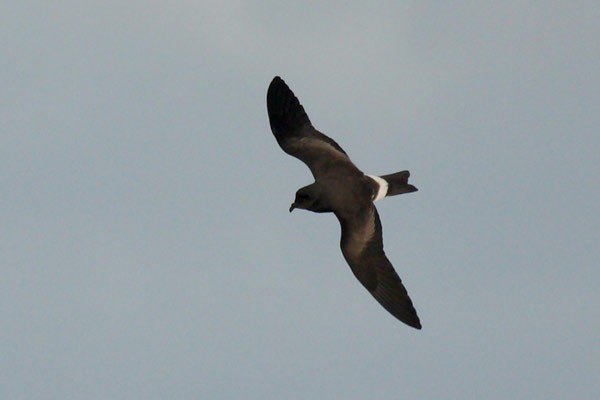
Monteiro’s Storm-Petrel—based on large samples of measured individuals at their Azorean breeding sites, Monteiro’s tends to have a more deeply notched tail than “Grant’s”, but their measurements overlap. (Offshore from Graciosa, Açores, Portugal; May 2011.) © Gareth Knass

“Gulf of Guinea Storm-Petrel”, H. c. ssp. nova, showing apparently thin rump-band and long-looking tail. © William H. Wagstaff
Monteiro’s Storm-Petrel (monteroi): Breeds in the Azores from March to October (eggs laid from early May to early July). Gives the shortest, simplest calls, with a rougher, scratchier quality than the others. Relatively small-bodied, long-tailed, and long-winged, and usually has a visibly notched tail.
“Grant’s Storm-Petrel” (ssp. nova): Breeds from the Azores east to the Berlengas and south to the Canaries from August to April (eggs laid from early October to early December). Calls end with signature punctuation. Relatively large and robust, and has a squarish or shallowly notched tail. Post-breeding adults show heavy feather-wear and/or molting flight feathers most noticeably from April to June—when Monteiro’s and “Madeiran” are fresh-plumaged.
“Madeiran Storm-Petrel” (castro): Breeds in Madeira, the Selvagens, and the Canaries from April to October (eggs laid in June and July). Calls are squeaky, rapid, about intermediate in length between Monteiro’s and Cape Verde, and lack the particular ending of “Grant’s”. Relatively small and slim overall; tail can appear either square-tipped or notched.
Cape Verde Storm-Petrel (jabejabe): Breeds in Cape Verde over an extended season, possibly year-round with two peaks—one from October into winter, the other from April into summer. Gives the longest, most complex calls, and genetic analyses indicate that it is the oldest divergent lineage in the band-rumped complex. Proportions are average, and has a squarish or shallowly notched tail.
“Gulf of Guinea Storm-Petrel” (ssp. nova): Breeds on São Tomé over an extended season, possibly year-round. Calls are relatively long and complex, suggesting an affinity with Cape Verde. Appears slightly larger than other forms, with a narrow white rump band and long-looking squarish or shallowly notched tail.
“St. Helena Storm-Petrel” (helena): Breeds on St. Helena and Ascension in two seasons—possibly multiple distinct forms or cryptic species—one from October to March, the other from April to September. Attends the nest diurnally. On some individuals the white rump band extends far down undertail coverts. Slightly larger than most other forms; usually shows a visibly notched tail.
Additional Photos of “Madeiran Storm-Petrel”
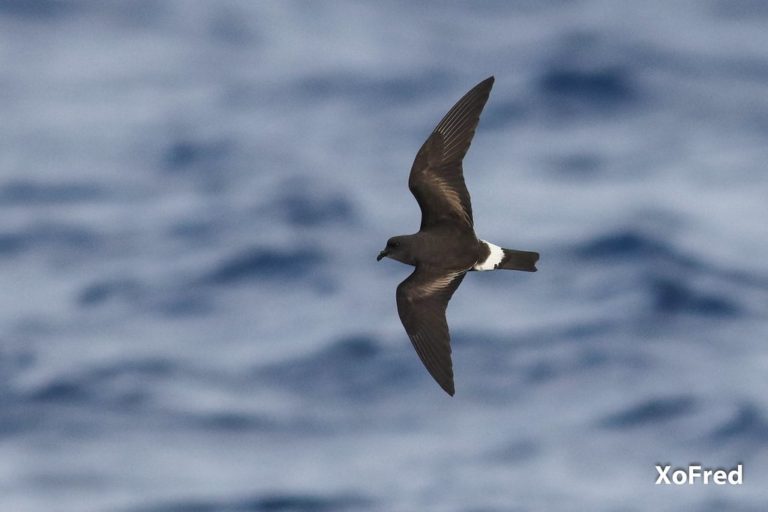
“Madeiran Storm-Petrel”, H. c. castro —presumed based on location, season, and molt-stage—showing notched tail. (Offshore north of Madeira; May 2019.) © XoFred

“Madeiran Storm-Petrel”, H. c. castro. (Offshore north of Ilhéu da Cevada, Madeira; June 7, 2011.) © Simon Colenutt

“Madeiran Storm-Petrel”, H. c. castro. (Offshore north of Ilhéu da Cevada, Madeira; June 7, 2011.) © Simon Colenutt
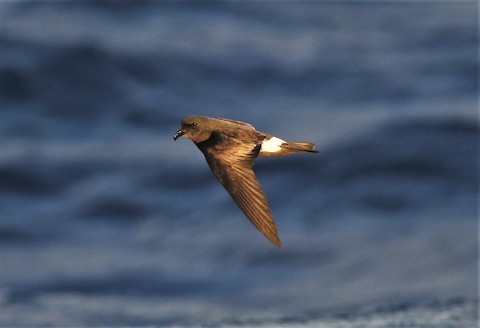
“Madeiran Storm-Petrel”, H. c. castro — likely this subspecies, based on molt-stage and season. (Offshore south of Funchal, Madeira; June 29, 2021.) © Peter Flood
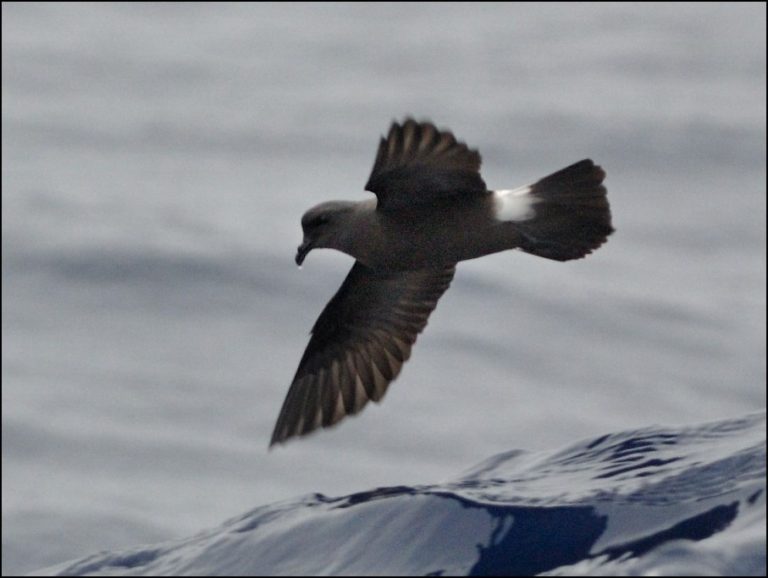
“Madeiran Storm-Petrel”, H. c. castro, with tail appearing wedge-shaped in this posture. (Offshore from Madeira; May 2011.) © Kirk Zufelt
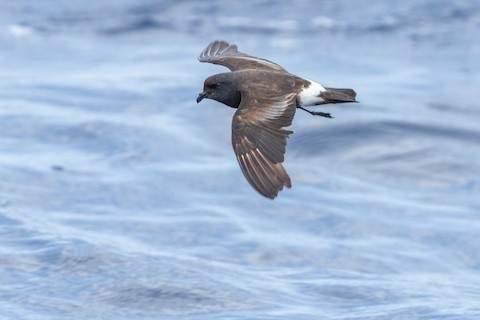
“Madeiran Storm-Petrel”, H. c. castro —likely this subspecies, based on molt-stage and season. (Banco de la Concepción, Canary Islands, Spain; September 12, 2021.) © Thibauld Aronson
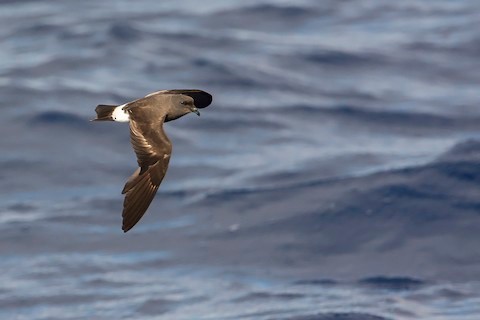
“Madeiran Storm-Petrel”, H. c. castro —likely this subspecies, based on molt-stage and season. (Banco de la Concepción, Canary Islands, Spain; September 13, 2015.) © Miguel Rouco
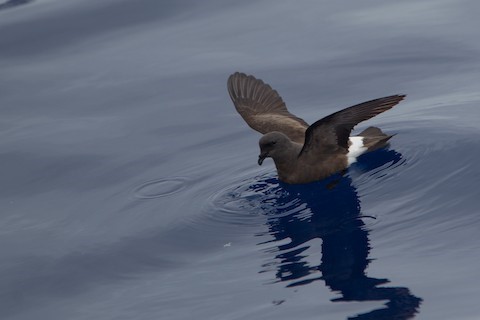
“Madeiran Storm-Petrel”, H. c. castro. (Offshore from Bugio, Madeira; June 8, 2011.) © Simon Colenutt
References
Alderfer, J., and J.L. Dunn. 2014. National Geographic Complete Birds of North America (Second Edition). National Geographic Society, Washington, D.C.
BirdLife International. 2018. Hydrobates castro. The IUCN Red List of Threatened Species 2018: e.T132341128A132433305. https://dx.doi.org/10.2305/IUCN.UK.2018-2.RLTS.T132341128A132433305.en. (Accessed December 29, 2021.)
Bolton, M., A.L. Smith, A. L., E. Gómez-Díaz, V.L. Friesen, R. Medeiros, J. Bried, J.L. Roscales, and R.W. Furness. 2008. Monteiro’s Storm Petrel Oceanodroma monteiroi: a new species from the Azores. Ibis 150:717-727.
eBird. 2021. eBird: An online database of bird distribution and abundance. Cornell Lab of Ornithology, Ithaca, N.Y. http://www.ebird.org. (Accessed December 29, 2021.)
Garcia-del-Rey, E. 2011. Field Guide to the Birds of Macaronesia: Azores, Madeira, Canary Islands, Cape Verde. Lynx Editions, Barcelona.
Garcia-del-Rey, E. 2018. Birds of the Canary Islands. Christopher Helm, London.
Harrison, P. 1983. Seabirds: An Identification Guide. Houghton Mifflin, Boston.
Howell, S.N.G. 2012. Petrels, Albatrosses & Storm-Petrels of North America. Princeton University Press.
Howell, S.N.G., and K. Zufelt. 2019. Oceanic Birds of the World. Princeton University Press.
Kirwan, G.M., A. Levesque, M. Oberle, and C.J. Sharpe. 2019. Birds of the West Indies. Lynx Edicions, Barcelona.
Onley, D., and P. Scofield. 2007. Albatrosses, Petrels & Shearwaters of the World. Princeton University Press.
Raffaele, H., J. Wiley, O. Garrido, A. Keith, and J. Raffaele. 1998. A Guide to the Birds of the West Indies. Princeton University Press.
Sibley, D.A. 2014. The Sibley Guide to Birds (Second Edition). Alfred A. Knopf. New York.
Svensson, L., K. Mullarney, and D. Zetterström. 2009. Birds of Europe (Second Edition). Princeton University Press.
Taylor, R.S., M. Bolton, A. Beard, T. Birt, P. Deane-Coe, A.F. Raine, J. González-Solís, S.C. Lougheed, and V.L. Friesen. 2019. Cryptic species and independent origins of allochronic populations within a seabird species complex (Hydrobates spp.). Molecular Phylogenetics and Evolution 139:106552.
The Sound Approach. 2019. Madeiran Storm-Petrel, Oceanodroma castro. https://soundapproach.co.uk/species/madeiran-band-rumped-storm-petrel/.
Xeno-Canto. 2021. Band-rumped Storm Petrel – Oceanodroma castro. https://xeno-canto.org/species/Oceanodroma-castro. (Accessed January 9, 2022.)
